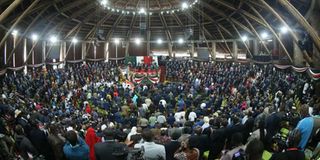Easy steps to improve the Constitution

The launch of the Building Bridges Initiative report at Bomas of Kenya, Nairobi, on October 26.
What you need to know:
- We are alive to the fact that constitutional changes the world over are always controversial.
- Since Rift Valley is too big and given its population, we could divide it into two, North and South
Some people insist that there is nothing fundamentally wrong with the 2010 Constitution. Well, I beg to differ. We voted for this Constitution not because it is anywhere near what we wanted, but because it was better than what we had. So yes, we need to change some aspects.
Let me outline the structural defects of the current Constitution. First, it is way too expensive. We wanted devolution, but it gave us devolved units that are unsustainable. It promised us gender equity, but gave no roadmap to achieving it.
We wanted to cut presidential powers, but it gave us an imperial presidency. On the other side, the Building Bridges Initiative proposals are uninspiring. We are, however, alive to the fact that constitutional changes the world over are always controversial.
Here’s my take on the 2010 Constitution.
Reduce the number of counties: This can be done by using the former (they are still in place only referred to as regions) provinces as the devolved units. That would give us manageable and sustainable eight counties. We can add two or three more counties to the eight to make them 10 or 11.
Since Rift Valley is too big and given its population, we could divide it into two, North and South. Since the population in the North Rift may be small, we could expand it a little to include parts of North Eastern. Likewise, Central could also, due to population, be divided into two after incorporating parts of Eastern Province. Western Province can also be divided, again after expanding the northern part of it to incorporate parts of Rift Valley. This will not only increase the revenue generation capacities of the devolved units, but will also reduce the cost of devolution.
Merge the number of constitutional commissions: While at it, reduce the number of commissioners per commission. You can as well do something about the number of interested parties in important commissions, like the number of judicial officers in the Judicial Service Commission.
Ensure gender parity: With, say, 10 counties, we will end up with only 10 senators. To ensure gender equity, we could have two senators per county, one from either gender giving us 20 senators. This may be done by legislating that the best male and the best female per county in a general election become the senators for the county.
The next step would be the number of constituencies. We need no more than 10 constituencies per county. If we chose this route, with 10 counties, we would end up with 100 MPs. Again for gender equity we could safely, and economically, have two MPs per constituency, one from each gender, resulting in 200 MPs. To take care of people living with disabilities, we could add 10 MPs and five senators, nominated, to represent this group.
This would give us a total of 235 members of the National Assembly. This way, we would have not only reduced the cost of the assembly but also sorted out the gender equity headache. To prevent stalemates, we should make the Senate an upper house. The number of MCAs could be limited to no more than 50 per county.
Presidential powers: Simply do away with the presidential system. If we must have a president, then make it a mixed system, either following the France or Indian models. If we intend to amend the Constitution, we should solve its problems, but what BBI is proposing looks like what we have been doing with our roads: fixing potholes in tarmacked sections by filling them up with (loam) soil.
Damianus Okaka, University of Witwatersrand, SA




